GAULEY BRIDGE, W.Va. — Though beautiful, the following tale of Kanawha Falls in West Virginia may not have originated with the Shawnee, as its unknown author purported, but around the campfires where storytellers practiced their art. The tale appears to show up in no other circumstance in Mountain State lore.*
Kanawha Falls and nearby Cathedral Falls are deserving of a legend, certainly. They are two of the most visited and best-known waterfalls in West Virginia. On scenic US-60, also known as the Old Midland Trail, they're favorite stops for passing travelers. Several are on the West Virginia Waterfall Trail.
It is likely, though it is never stated, that the character "Tall Song" is Cathedral Falls, in which weddings have long taken place. Readers are encouraged to help us identify which of the other waterfalls mentioned are represented by corresponding descriptions in the tale and add their comments at the end of the article. Would you like to share a photo of one of the waterfalls? Let us know. Email editor@wvexplorer.com.
We'd also like to encourage hikers, paddlers, and sightseers exploring the region to use care when visiting the waterfalls. The rocks around the waterfalls can be slippery. Kayakers and other boaters should always use life jackets.
The Legend of Kanawha Falls and Her Daughters
As told among the Shawnee who walked these valleys long before the white man came
Long before the trails were cut by iron axes or the rivers were scarred by men’s boats, the Kanawha Valley was a place of deep and secret voices. The rivers did not flow as they do now, and the cliffs and gorges were still learning their shapes. In those days, the people of the Shawnee say, water was not only water—it was spirit, and each stream or fall was a living woman with a mind and a will.
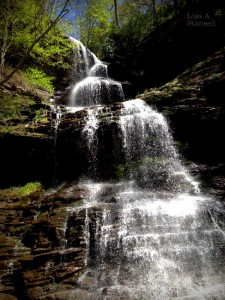
The greatest of these was Kanawha Mother, whose real name in the old tongue has been lost, though the elders say it meant She-Who-Sings-to-the-Stones. She was tall as a pine and strong as the spring floods, and her hair was black and endless, like the river at night. She lived in a wide, slow pool where the river bent, and from her breast poured the water that fed all the streams of the valley.
Kanawha Mother was not a human woman but a water-spirit—half flesh, half current—yet she loved the people of the valley. She would rise from the water in the evening, her hair streaming silver in the moonlight, to speak to the young hunters or bring fish close to the spears of the women. She was kind, but she was also fierce, for she guarded the valley against those who would harm it.
Kanawha Mother had eight daughters, each born from her in a different season, each gifted with beauty and a voice of her own. When they were small, they played in the shallows and laughed among the reeds, but as they grew, Kanawha Mother sent them out to live in the cliffs and high streams, so they could watch over all the corners of the valley.
The daughters were as follows:
- Little Foxwater, quick and playful, whose fall was small but bright, leaping down a stair of rocks in silver steps.
- Mist-in-the-Sycamore, shy and dreamy, whose veil of spray drifted into the forest so that sycamore leaves glistened even on dry days.
- White Plume, straight and proud, poured herself in one clean drop from the cliff.
- Shadow Veil, who hid behind mossy stones and only revealed her shining face to those who came close.
- Laughing Spray, whose tumbling waters sounded like a girl’s laughter echoing through the gorge.
- Two Sisters, twins who fell side-by-side, so alike they could not be told apart except by those who had watched them since birth.
- River Bride, who descended gently, as though dancing, to meet the main river below.
- And the youngest and most beautiful, Tall Song—the tallest fall in all the region, whose white water plunged down the high stone face. Her voice was a hymn to the sky, and her spray shone like a crown when the sun struck her.
The Shawnee say Tall Song was so beautiful because Kanawha Mother had carried her longer than the others, keeping her close as she grew. And though Tall Song loved her mother, she often looked toward the far ridges, yearning for the wide world beyond.
For a time, the valley was peaceful. The daughters guarded the lands and warned of approaching storms or enemies. But one summer, a drought fell upon the region. The streams thinned to threads, and the fish hid in the deep holes. Even the great Kanawha Mother felt her strength weakening.
It was then that a stranger came—a man of fire, not of water. The people remember him only as Red-Eye, for his eyes burned like coals. He was a spirit from beyond the mountains, where the earth is dry and cracked, and he envied the beauty of the Kanawha Valley. Red-Eye told Kanawha Mother he wished to take one of her daughters as his wife and carry her back to his land.
Kanawha Mother refused. She said her daughters belonged to the valley, as the rain belongs to the clouds. But Red-Eye’s desire only grew. He wandered among the cliffs, watching each daughter in turn, until his gaze fixed upon Tall Song. Her long, bright fall, her proud face, her song that filled the air—these stirred his heart like nothing he had ever known.
One night, under a sky without stars, Red-Eye came to Tall Song’s pool. He spoke in soft words, promising her lands beyond the ridges where the sun rose red, and skies never knew cold. Tall Song listened, for she was young and curious, but she said she could not leave her mother.
Red-Eye’s temper flared. He reached into the pool and tried to bind her with cords of smoke and heat, to carry her away. But Kanawha Mother felt the struggle and came surging from her own wide falls, the river roaring in her voice.
The battle shook the valley. Water crashed against fire, steam shrouded the cliffs, and lightning tore across the sky. The daughters joined their mother, each pouring her full strength into the fight. Mist-in-the-Maples cloaked the enemy in fog, White Plume struck like a spear, Laughing Spray shouted defiance, and Tall Song’s voice rose above them all like a bell.
At last, Kanawha Mother wrapped herself around Red-Eye, sweeping him down the valley. She struck him against the rocks again and again until his fire dimmed to embers, and then she cast him far away, into the western hills where no river runs.
But the battle had cost the water-spirits dearly. In her fury, Kanawha Mother had flung herself over a wide ledge of stone, and there she remained, her body becoming the broad Kanawha Falls we see today. She still sings to her daughters, but she cannot walk the valley as she once did. The daughters, too, were changed—their pools and channels fixed into the cliffs, so they could never leave the places they had defended.
Tall Song found herself set high above the valley floor, her waters dropping farther than any of her sisters’. She wept for her mother, and her tears made her fall even greater. The people say that on certain mornings, when the sun strikes Cathedral Falls just so, you can see the silver form of a young woman leaning from the cliff, her hair trailing in the wind.
The Shawnee who traveled through the valley in later years told this story to the white settlers they met. They said the eight daughters still watch over the valley, and that Kanawha Mother herself guards the river against any spirit or man who would take what is not theirs. Tourists who come now to see Kanawha Falls and her daughters do not always hear the story, but the water-voices are still there for those who listen.
And some say—when the river is high, and the mist is thick—you can hear Kanawha Mother calling her daughters by their old names, and their answering songs tumbling down the stone walls of the valley.
This is why the falls of the Kanawha Valley are not merely water, but a family—a mother and eight daughters, bound forever to their home by love, sacrifice, and the memory of a night when fire tried to steal water, and water stood her ground.
* The only source of this information I have ever found is a copy of an undated, unauthored, typewritten manuscript that has been in my possession since about 1996. From whence it came, I know not, but at that time, I was a publisher of magazines for Thomson Newspapers, working in Beckley, and had the opportunity to come across many such documents.
Visiting Kanawha Falls and Cathedral Falls
Kanawha Falls and Cathedral Falls are located in southern West Virginia on US-60, a 50-minute drive east of the state capital at Charleston, West Virginia, and a 30-minute drive west of the New River Gorge National Park and Preserve near Fayetteville, West Virginia. Part of Kanawha Falls can be viewed from a parking area just downstream in the Kanawha Falls Wildlife Management Area. Many kayakers visit a larger section of the falls that is inaccessible to most visitors.
Cathedral Falls is easily accessible and is highly visited and photographed. Motorists should be aware of the difficulty parking near both waterfalls during the summer tourist season. Several other waterfalls along the way are smaller but no less beautiful, and parking areas are located near them.
Kanawha Falls / Cathedral Falls Map
Legend of Van Bibber's Leap echoes in West Virginia's Kanawha Valley
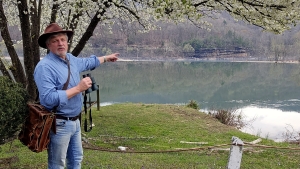
GLEN FERRIS, W.Va. — The arrival of spring in what would become West Virginia in the late 1700s was not met with the enthusiasm with which we might greet it today, for fair weather also increased the potential for attack by native tribes. While the Iroquois and Cherokee had ceded their claim to the region west of the Alleghenies, the Shawnee had not, and their braves were raiding European settlements whenever the opportunity arose. READ THE FULL STORY HERE.
Sign up to receive a FREE copy of West Virginia Explorer Magazine in your email weekly. Sign me up!
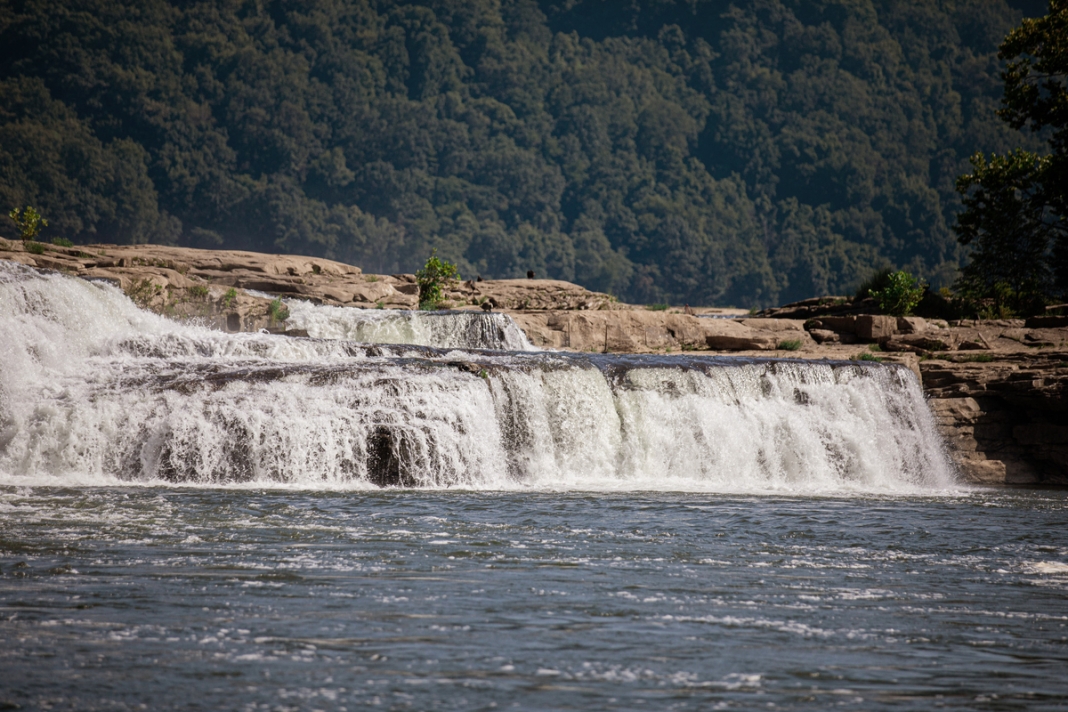
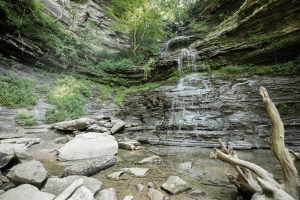
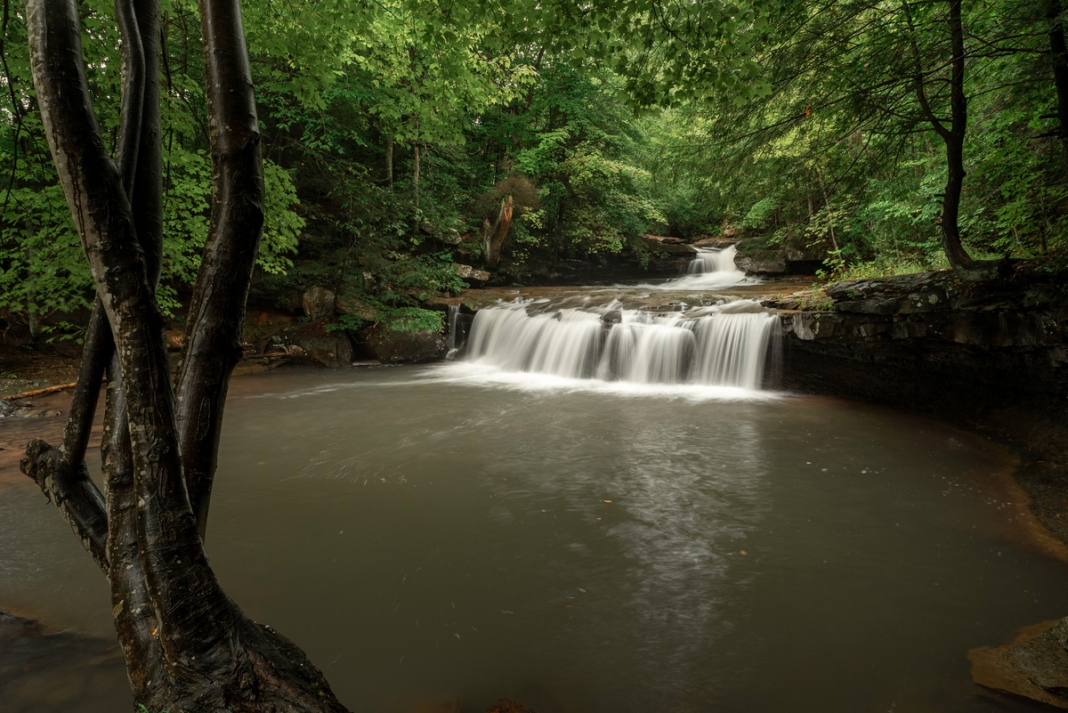

Bred and born in the area of the Falls, I’ve never heard the stories and would like to know the reference materials on which this story is based.
These stories or Folk Tales should be written in book story format and sold at the Tamarack and other WV visitors centers! Interested in reading these stories more completely if there are copies already available. Information appreciated.
I have never heard these lovely stories. I love Kanawha Falls and Cathedral Falls and visit quite frequently.
Is it mist-in-the-sycamore, or mist-in-the-maples? Does an editor read these, or do you just put them out without a thought?